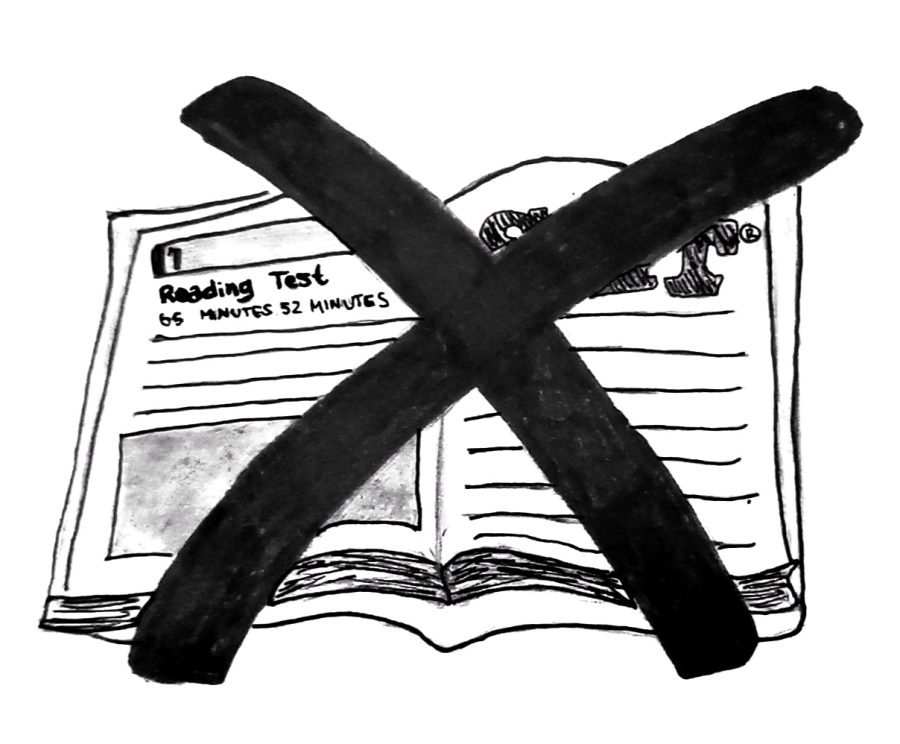The SAT is a Necessary Failure
December 1, 2022
In March of this year, the University of California system made a bold decision to permanently drop SAT and ACT requirements for college admissions, extending an earlier decision made during the pandemic. Paralleling the precedent they set in 1960 by signing onto the SAT, America’s largest public university system moving away from standardized testing is prompting many other institutions to consider doing the same. While all of these colleges have good reason to warrant eliminating the SAT requirement, the SAT is far too fundamental to the college admissions process to be abandoned without crippling the entire process and putting students’ futures at risk. This current test-optional system for college admissions isn’t sustainable and will end up doing more harm than good. Although it is a biased exam, the SAT requirement should stay.
Institutions only give disadvantaged students false hope when claiming they are “test-optional.” According to Command Education, in 2021 90% of Georgetown University’s class of 2025 submitted SAT/ACT scores, as well as 61.1% of Vanderbilt University students. Although the schools may be test-optional, students risk lowering their chances of admission by not submitting the best score they can get.
Moreover, removing the SAT requirement will create unequal applications for students of different income brackets because those who can afford to will choose to take the exam while those who cannot may opt out. When the SAT is a requirement, students are forced to present colleges with an equal application, and that may be by acquiring their test score with financial aid, a step lower income students may not feel obligated to take if test scores are not a requirement. This will tilt the scale so more higher income students submit SAT scores than lower income students, furthering the rift between the educational opportunities afforded to students of different socioeconomic status.
The issue most discussed about the SAT is that it does not align well with standard American high school curriculums, meaning the SAT tests students on their ability to master the SAT more than anything else. Those that can afford test prep materials and courses are more likely to succeed than those who cannot. However, the SAT gives colleges something no other requirement in the admissions process can: an unwavering, simple, statistic that remains relatively unchanged over time. With the average high schooler applying to six schools every year, most colleges don’t have time to spend even a minute on each application. Hard statistics, like SAT scores (although a poor academic indicator) and GPA, become their best friends because these numbers can give them a sense of which applicant is a good fit, academically, for their institution. However, GPA can be a wildly fluctuating measurement: not only is it subject to grade inflation over time, but letter grades also are not universal (so an A in Edison, New Jersey might be of a completely different value than an A in Los Angeles).
This is not the case for SAT scores, which make them much more reliable in colleges’ eyes. Removing the requirement to submit these scores takes away a lot of the automation in the admissions process. To get rid of the SAT would be synonymous with demolishing a load-bearing pillar in the building of college admissions—the entire structure would fall apart without it. Colleges will have to spend more money and more time without the SAT statistic on each application, which in turn will increase tuition and may lead to a lot of deserving students not getting admitted. The SAT might not favor individual students in their applications, but in the grander scheme, it oils the machine of admissions.
Furthermore, SAT scores are a very effective way for low to middle-income students to stand out to colleges and scholarship programs. Even if colleges decide to make admissions significantly more tedious by removing the test requirement, diligent students will still take the test to stand out. This trend became very prevalent in the pandemic: according to the Wall Street Journal, 200,000 more students (class of 2020) took the SAT despite the fact that the pandemic spurred around 1600 institutions in the USA to not require test scores. In this sense, college admissions will never be test free anyway, and keeping the SAT requirement will benefit more students than harm.
The SAT does have its larger, lesser-known shortcomings. Since its founding in the 1920s by eugenist and white supremacist Carl Brigham, the test is biased against minorities. In “A Study of American Intelligence,” Brigham analyzed the test results from an early version of the SAT administered to Army recruits. He reports that American education is declining “and will proceed with an accelerating rate as the racial mixture becomes more and more extensive,” proving a bias that was maintained for decades.
In the latter half of the twentieth century, according for a Forbes article, SAT test writers continued to engage in discriminatory practices by designing a system in which the current SAT writes future tests; questions that more white students got correct were kept for the next year’s exam while questions that more Black or Latinx students got right were removed. Furthermore, the data today show a clear discrepancy between the scores of students from different income brackets. Even with the recent intense reforms to the test, issues with the exam are still prevalent.








































